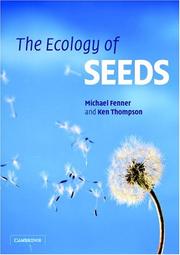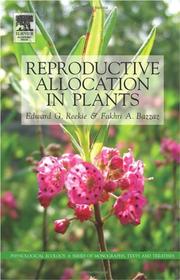| Listing 1 - 10 of 12 | << page >> |
Sort by
|
Book
ISBN: 1135325650 1280103787 0203345991 9786610103782 1135325669 Year: 1999 Publisher: Oxford : BIOS Scientific Publishers,
Abstract | Keywords | Export | Availability | Bookmark
 Loading...
Loading...Choose an application
- Reference Manager
- EndNote
- RefWorks (Direct export to RefWorks)
This book offers a fascinating and thorough examination of those factors which affect the sex determination of plant species.; It describes all of the main classes of plant with unisexual flowers - hermaphrodite, monoecious and dioecious species - and loo

ISBN: 9780511614101 9780521653114 9780521653688 0511082002 9780511082009 0511081553 9780511081552 0511614101 0521653681 0521653118 0521653118 1280417609 9781280417603 9781107128347 110712834X 9786610417605 0511196342 0511170823 0511323964 Year: 2004 Publisher: Cambridge : Cambridge University Press,
Abstract | Keywords | Export | Availability | Bookmark
 Loading...
Loading...Choose an application
- Reference Manager
- EndNote
- RefWorks (Direct export to RefWorks)
What determines the number and size of the seeds produced by a plant? How often should it reproduce them? How often should a plant produce them? Why and how are seeds dispersed, and what are the implications for the diversity and composition of vegetation? These are just some of the questions tackled in this wide-ranging review of the role of seeds in the ecology of plants. The authors bring together information on the ecological aspects of seed biology, starting with a consideration of reproductive strategies in seed plants and progressing through the life cycle, covering seed maturation, dispersal, storage in the soil, dormancy, germination, seedling establishment, and regeneration in the field. The text encompasses a wide range of concepts of general relevance to plant ecology, reflecting the central role that the study of seed ecology has played in elucidating many fundamental aspects of plant community function.
Seeds --- Plants --- Gemmation (Botany) --- Plant reproduction --- Plant physiology --- Reproduction --- Plants, Sex in --- Plant spores --- Seed ecology --- Ecology. --- Reproduction. --- Seeds - Ecology --- Plants - Reproduction
Periodical
Abstract | Keywords | Export | Availability | Bookmark
 Loading...
Loading...Choose an application
- Reference Manager
- EndNote
- RefWorks (Direct export to RefWorks)
Sexual Plant Reproduction covers the dynamics and mechanisms of sexual processes in all plants, including seed and non-seed plants. Principal emphasis is placed on the experimental approaches using biochemical, molecular, biophysical and immunological methods. The journal also publishes descriptive reports providing new insights on sexual reproduction based on submicroscopic and cytochemical methods. The journal presents original contributions, short communications, contemporary reviews and commentaries on subjects interesting to the community of sexual plant reproduction researchers. Coverage includes meiotic mechanisms; differentiation of plant sexual expression; male and female gametogenesis, and their related gene expression; self-incompatibility, self-incongruity and mechanisms of their regulation; pollen-stigma interaction and mechanisms of gamete attraction and fusion; fertilization mechanisms, gamete recognition and fusion mechanisms; control of early embryogenesis and more.
Botany --- Plants --- Plants, Sex in --- Plantes --- Reproduction --- Periodicals --- Périodiques --- Sexualité --- Sexualité --- Agriculture Sciences --- Life Sciences --- Plant Breeding --- Germany --- periodical --- Sex in plants --- Plant physiology --- Sex (Biology) --- Flora --- Plant kingdom --- Plantae --- Vascular plants --- Vegetable kingdom --- Vegetation --- Wildlife --- Organisms --- Reproduction. --- Plants, Sex in.
Periodical
Abstract | Keywords | Export | Availability | Bookmark
 Loading...
Loading...Choose an application
- Reference Manager
- EndNote
- RefWorks (Direct export to RefWorks)
Plants --- Plant breeding --- Plant genetics --- Plant breeding. --- Plant genetics. --- Reproduction --- Reproduction. --- Gemmation (Botany) --- Plant reproduction --- Crops --- Flora --- Plant kingdom --- Plantae --- Vascular plants --- Vegetable kingdom --- Vegetation --- Wildlife --- Genetics --- Breeding --- Plant physiology --- Plants, Sex in --- Plant spores --- Agriculture --- Organisms --- Botany
Book
ISBN: 128052488X 9786610524884 0198021925 9780198021926 019770185X Year: 2023 Publisher: Oxford : Oxford University Press,
Abstract | Keywords | Export | Availability | Bookmark
 Loading...
Loading...Choose an application
- Reference Manager
- EndNote
- RefWorks (Direct export to RefWorks)
This collection of reviews by leading investigators examines plant reproduction within a framework of evolutionary ecology. The contributors cover sex allocation; sexual selection and inclusive fitness; paternity and maternity; the evolution, maintenance, and loss of self-incompatibility in plants; and sex dimorphism. Together these studies focus on the complexities of plant life cycles and the distinctive reproductive biologies of these organisms, while showing the similarities between non-flowering plants and the more thoroughly documented flowering species.
Plant ecology. --- Plants. --- Plants --- Plant ecology --- Botany --- Plant Physiology --- Earth & Environmental Sciences --- Reproduction --- Gemmation (Botany) --- Plant reproduction --- Ecology --- Plant physiology --- Plants, Sex in --- Plant spores --- Phytoecology --- Vegetation ecology --- Floristic ecology --- Reproduction.

ISBN: 1526130173 9781526130174 9780719076978 0719076978 9780719088452 0719088453 Year: 2017 Publisher: MANCHESTER MANCHESTER UNIV Press
Abstract | Keywords | Export | Availability | Bookmark
 Loading...
Loading...Choose an application
- Reference Manager
- EndNote
- RefWorks (Direct export to RefWorks)
In this fascinating study, Samantha George explores the cultivation of the female mind and the feminised discourse of botanical literature in eighteenth-century Britain. In particular, she discusses British women's engagement with the Swedish botanist, Carl Linnaeus, and his unsettling discovery of plant sexuality. Previously ignored primary texts of an extraordinary nature are rescued from obscurity and assigned a proper place in the histories of science, eighteenth-century literature, and women's writing. The result is groundbreaking: the author explores nationality and sexuality debates in relation to botany and charts the appearance of a new literary stereotype, the sexually precocious female botanist. She uncovers an anonymous poem on Linnaean botany, handwritten in the eighteenth century, and subsequently traces the development of a new genre of women's writing - the botanical poem with scientific notes. The book is indispensable reading for all scholars of the eighteenth century, especially those interested in Romantic women's writing, or the relationship between literature and science.
Plants, Sex in --- Women botanists --- Botany in literature --- Botanical literature --- Biological literature --- Botany --- Botanists --- Women biologists --- Women in botany --- Sex in plants --- Plant physiology --- Sex (Biology) --- Plants --- History --- Women authors --- Reproduction --- Linne, Carl von, --- Influence. --- Linné, Carl von, --- Linnaeus, Carl, --- Linneĭ, Karl, --- Linnaeus, Carolus, --- Von Linné, Carl, --- Linnaeus, C., --- Linneus, --- Linné, Carolus a, --- Linné, Charles, --- Lineu, Carlos, --- Plants, Sex in. --- Literature --- Literary Theory --- LITERARY CRITICISM / European / English, Irish, Scottish, Welsh` --- Ireland --- Authorship --- History and criticism. --- British women's engagement. --- Carl Linnaeus. --- Collinsonia. --- Erasmus Darwin. --- Linnaean Sexual System. --- Linnaean classification. --- Mary Wollstonecraft. --- botanical classification. --- botanical literature. --- eighteenth-century Britain. --- female mind. --- female modesty. --- floristry. --- plant sexuality. --- sexual anxiety.
Book
ISBN: 813222003X 8132220021 Year: 2014 Publisher: New Delhi : Springer India : Imprint: Springer,
Abstract | Keywords | Export | Availability | Bookmark
 Loading...
Loading...Choose an application
- Reference Manager
- EndNote
- RefWorks (Direct export to RefWorks)
Successful reproduction is the basis not only for the stability of the species in their natural habitat but also for productivity of our crop plants. Therefore, knowledge on reproductive ecology of wild and cultivated plants is important for effective management of our dwindling biodiversity and for the sustainability and improvement of the yield in crop species. Conservation and management of our plant diversity is going to be a major challenge in the coming decades, particularly in the tropical countries which are rich in biodiversity. Reproductive failure is the main driver for pushing a large number of tropical species to vulnerable category. Available data on reproductive ecology on tropical species is very limited and there is an urgent need to initiate research on these lines. A major limitation for the beginners to take up research is the absence of simple concise work manuals that provide step-wise procedures to study all aspects of reproductive ecology. The Manual fills this void. Over 60 protocols described in the Manual cover the whole spectrum of reproductive ecology - study sites and species, phenology, floral morphology and sexuality, pollen and pistil biology, pollination ecology, breeding system, seed biology, seed dispersal and seedling recruitment. Each chapter gives a concise conceptual account of the topic before describing the protocols. The Manual caters to researchers, teachers and students who are interested in any aspect of reproductive ecology of flowering plants -- botanists, ecologists, agri-horticulturists, foresters, entomologists, plant breeders and conservation biologists. .
Plants --- Reproduction. --- Gemmation (Botany) --- Plant reproduction --- Plant physiology --- Reproduction --- Plants, Sex in --- Plant spores --- Botany. --- Plant Ecology. --- Plant breeding. --- Plant Sciences. --- Plant Breeding/Biotechnology. --- Crops --- Agriculture --- Breeding --- Botany --- Ecology --- Botanical science --- Phytobiology --- Phytography --- Phytology --- Plant biology --- Plant science --- Biology --- Natural history --- Phytoecology --- Vegetation ecology --- Plant science. --- Plant ecology. --- Floristic botany --- Floristic ecology
Book
ISBN: 3319212532 3319212540 Year: 2015 Publisher: Cham : Springer International Publishing : Imprint: Springer,
Abstract | Keywords | Export | Availability | Bookmark
 Loading...
Loading...Choose an application
- Reference Manager
- EndNote
- RefWorks (Direct export to RefWorks)
The first part of the book presents the evolution of plants starting from photosynthetic cells to topics like Gymnosperms and Angiosperms, including the evolution of the breeding system. Geological and molecular data were used, helping us to show with more details each of the phases presented. Also, specialization of the reproductive systems such as evolution of unissexuality (dioecy and monoecy), evolution of self-incompatibility, selfing fertilization and mixed mating systems were considered. The last part discusses the biology and genetics of the reproductive systems and shows the strategies that modern plants use in asexual reproduction (vegetative and apomictic reproduction) and sexual reproduction. In addition, the sexual reproduction topics such as gametogenesis, the genetic control of reproductive organs, systems that promote outcrossing, selfing and mixed mating systems were also included. .
Plant Sciences --- Agriculture - General --- Agriculture --- Earth & Environmental Sciences --- Plants --- Plant genetics. --- Reproduction. --- Evolution. --- Plant evolution --- Gemmation (Botany) --- Plant reproduction --- Genetics --- Life sciences. --- Cytogenetics. --- Plant physiology. --- Plant breeding. --- Life Sciences. --- Plant Breeding/Biotechnology. --- Plant Physiology. --- Plant physiology --- Reproduction --- Plants, Sex in --- Plant spores --- Evolution (Biology) --- Phylogeny --- Human genetics. --- Heredity, Human --- Human biology --- Physical anthropology --- Botany --- Physiology --- Crops --- Breeding --- Cytology

ISBN: 0120883864 9786610633210 1280633212 008045433X 9780120883868 9780080454337 Year: 2005 Publisher: Burlington : Elsevier Academic Press,
Abstract | Keywords | Export | Availability | Bookmark
 Loading...
Loading...Choose an application
- Reference Manager
- EndNote
- RefWorks (Direct export to RefWorks)
Much effort has been devoted to developing theories to explain the wide variation we observe in reproductive allocation among environments. Reproductive Allocation in Plants describes why plants differ in the proportion of their resources that they allocate to reproduction and looks into the various theories. This book examines the ecological and evolutionary explanations for variation in plant reproductive allocation from the perspective of the underlying physiological mechanisms controlling reproduction and growth. An international team of leading experts have prepared chapters summar
plants --- plant population --- population dynamics --- autecology --- reproduction. --- reproduction --- Plant reproductive organs --- propagation materials --- biological development --- life cycle --- site factors --- ecological succession --- Biological competition --- Plants --- Plant ecophysiology. --- Environmental plant physiology --- Physiological plant ecology --- Plant physiological ecology --- Ecophysiology --- Plant ecology --- Plant physiology --- Gemmation (Botany) --- Plant reproduction --- Reproduction --- Plants, Sex in --- Plant spores --- Reproduction.
Book
ISBN: 9780511975943 9780521880954 9780521707374 9781139076999 113907699X 9781139079273 1139079271 0521880955 1107218993 1139062638 1283112949 9786613112941 1139074741 1139068962 0511975945 1139081551 Year: 2011 Publisher: Cambridge : Cambridge University Press,
Abstract | Keywords | Export | Availability | Bookmark
 Loading...
Loading...Choose an application
- Reference Manager
- EndNote
- RefWorks (Direct export to RefWorks)
Darwin identified the existence of separate male and female gametes as one of the central mysteries of evolutionary biology. 150 years later, the question of why male gametes exist remains an intriguing puzzle. In this, the first book solely devoted to the evolution of anisogamy, top theorists in the field explore why gamete dimorphism characterizes nearly all plants and animals. Did separate male and female gametes evolve as a result of competition, or does anisogamy instead represent selection for cooperation? If disruptive selection drove the evolution of anisogamy, with male gametes focused on search and fusion, and female gametes provisioning the new zygote, why do some algal species continue to produce gametes of a single size? Does sperm limitation, or escape from infection, better explain the need for extremely small, highly mobile sperm? Written by leaders in the field, this volume offers an authoritative and cutting-edge overview of evolutionary theory.
Gametes --- Gametogenesis. --- Natural selection. --- Plants --- Reproduction, Asexual. --- Asexual reproduction --- Gemmation (Zoology) --- Spores --- Gemmation (Botany) --- Plant reproduction --- Plant physiology --- Reproduction --- Plants, Sex in --- Plant spores --- Darwinism --- Selection, Natural --- Genetics --- Variation (Biology) --- Biological invasions --- Evolution (Biology) --- Heredity --- Formation of gametes --- Cell differentiation --- Germ cells --- Evolution. --- Reproduction. --- Formation
| Listing 1 - 10 of 12 | << page >> |
Sort by
|

 Search
Search Feedback
Feedback About
About Help
Help News
News